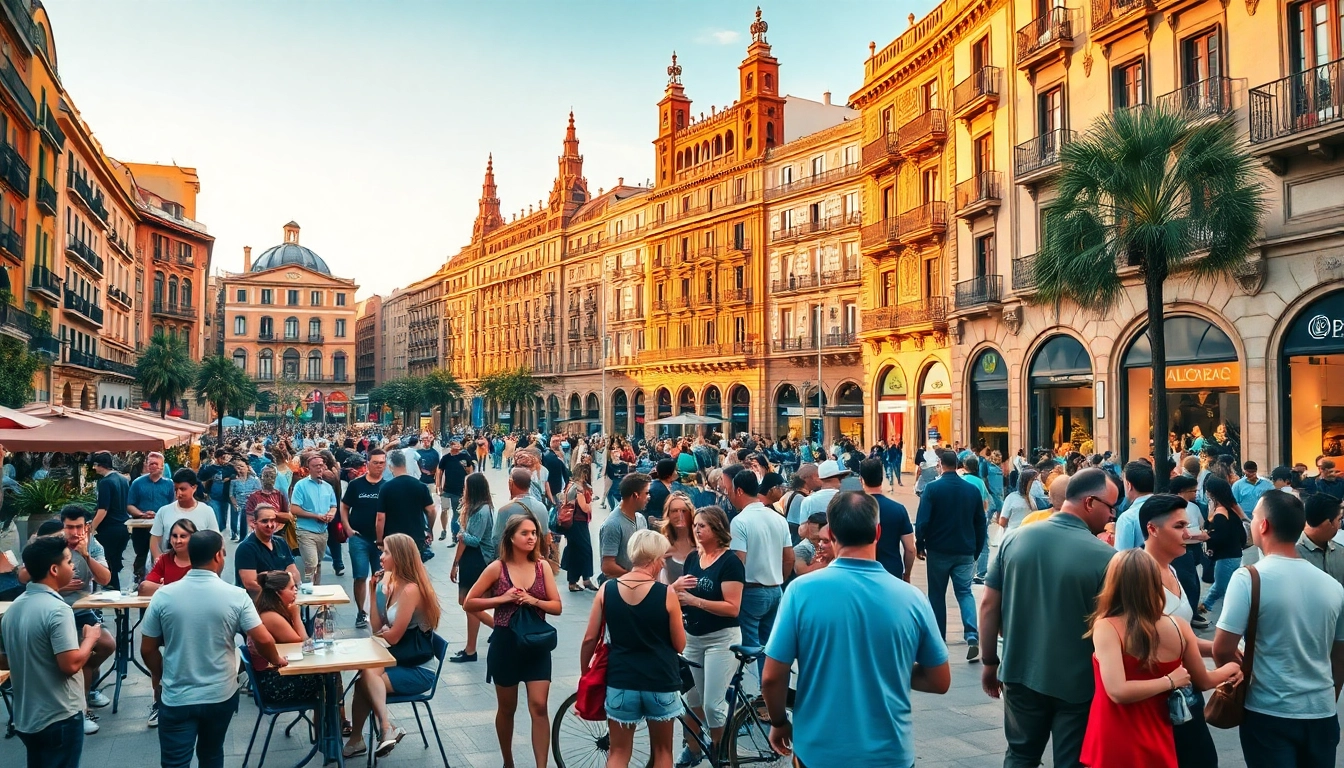The Ultimate Guide to Barcelona Population Dynamics and Trends

Understanding Barcelona Population: Key Statistics
Current Population Figures
Barcelona, the vibrant capital of Catalonia in Spain, is recognized not only for its rich cultural heritage but also for its significant population statistics. As of the latest census data, the city boasts a population of approximately barcelona population that hovers around 1.73 million within the city limits. This figure is particularly notable as it represents the highest population recorded in over four decades, demonstrating the steady growth the city has experienced amidst various socio-economic changes. Furthermore, it’s essential to note that the urban area extends beyond the city limits, encompassing nearly 6 million residents in the broader metropolitan region.
Demographic Breakdown of Barcelona Population
The demographic landscape of Barcelona offers insights into its diverse population. Approximately 17.6% of the city’s inhabitants are non-nationals, highlighting the city’s role as a multicultural hub. Foreign-born nationals represent around 20.7% of the total population, adding to the city’s richness in cultural plurality. Age distribution also plays a critical role in understanding the population dynamics. The population is relatively young with a significant portion aged between 25 and 44 years, reflecting the city’s attractiveness, especially to young professionals and students.
This demographic mix encompasses numerous ethnicities, where the largest groups are of Spanish, Catalan, and various Latin American origins. Such diversity not only impacts the cultural fabric of the city but also influences the social and economic landscape, particularly in sectors like tourism, gastronomy, and arts.
Historical Population Trends in Barcelona
Looking back at historical data, the population of Barcelona has seen dramatic changes. In the mid-20th century, the population was recorded at approximately 1.8 million. This figure gradually declined due to various factors such as economic downturns and urban migration trends particularly seen in the late 20th century. Recovery began in the early 2000s, and particularly following the 1992 Olympic Games, which served as a catalyst for urban revitalization. The subsequent years saw a steady increase, fueled by factors such as improved economic conditions, an influx of migrants, and the city’s enhanced global standing.
Factors Influencing Barcelona Population Growth
Migration Patterns Impacting Barcelona Population
Migration patterns play a pivotal role in shaping Barcelona’s population dynamics. The city has historically attracted individuals from various parts of Spain and the world. Economic opportunity is a significant driving force, as many individuals seeking employment in sectors such as technology, tourism, and culture move to the city. Moreover, Barcelona’s renowned education institutions attract numerous students from both local and international backgrounds, further increasing its population. This combined influx of both skilled and unskilled labor has contributed to the slower yet steady population growth over the years.
Economic Factors Driving Population Changes
The economic landscape of Barcelona significantly influences population changes. With its robust economy, characterized by tourism, commerce, technology, and the creative sectors, it offers numerous job opportunities. The unemployment rate has steadily decreased, making it a desirable destination for migrants. Additionally, the city’s infrastructure investments and sustained economic growth foster an environment conducive to business, attracting not only locals but also international residents seeking a better standard of living.
Urban Development Effects on Barcelona Population
Urban development and planning have had profound effects on Barcelona’s population. Major infrastructural projects, including the extension of public transportation networks and the development of sustainable housing, have sought to accommodate the growing population effectively. Areas such as 22@ in Poblenou have been transformed into tech hubs, enhancing attractiveness for professionals. Additionally, ongoing urban renewal projects aim to improve living conditions and access to amenities, directly influencing population numbers as people are drawn to these enhanced living environments.
Comparative Analysis of Barcelona Population
Barcelona Population vs. Other Major European Cities
When compared to other major European cities, Barcelona holds a unique position in terms of population dynamics. While cities like Paris and London show significantly higher population figures, Barcelona’s density and growth rate offer a distinct narrative. The city’s average population density stands at about 16,000 inhabitants per square kilometer, making it one of the most densely populated cities in Europe. In contrast, cities like Berlin exhibit lower density figures, which can lead to different urban planning challenges and opportunities.
Shifts in City Population Over the Decades
Over the decades, shifts in Barcelona’s population have reflected broader socio-political and economic trends. From post-war recovery to the influx during the economic boom, coupled with recent trends post-COVID-19, the city has experienced fluctuating dynamics. The rise of remote work prompted some population shifts, with individuals seeking to balance work and lifestyle, influencing the demographic movement within and outside the city.
Metropolitan Area Overview: Barcelona Population Insights
The metropolitan area of Barcelona, known for its extensive network of municipalities, contributes significantly to the total population numbers. Estimates suggest that around 5.7 million people reside in the metro area, with suburbs expanding multifold. Many individuals opt to live in surrounding areas while commuting to the city, thereby affecting urban dynamics, housing markets, and daily transit patterns. This intertwined relationship postulates that the core city is not solely reflective of population changes but rather part of a larger metropolitan context.
Challenges Related to Barcelona Population Growth
Infrastructure Strain from Rising Barcelona Population
As the population continues to rise, infrastructure strain emerges as a pressing issue. Public transport systems, housing, and public services are under significant pressure to adapt. The city has witnessed instances of overcrowding in public transport during peak hours, leading to increased demands for infrastructural investments and developments. Furthermore, the challenge of housing affordability grows as rising demand juxtaposes limited availability, forcing locals and newcomers alike to navigate often challenging real estate markets.
Social Integration Challenges within Barcelona Population
Social integration also poses challenges to the increasingly diverse population of Barcelona. The influx of foreign nationals has necessitated programs and services aimed at promoting social cohesion and understanding among various cultural groups. However, issues regarding integration, discrimination, and cultural acceptance remain prevalent. City initiatives aimed at cultural education and community engagement are critical for fostering an inclusive environment, addressing potential societal frictions, and promoting shared societal values.
Environmental Impact of Increasing Barcelona Population
The environmental impact of an increasing population is another crucial concern. From waste management to energy consumption, the city grapples with sustainability issues. More inhabitants inevitably mean higher resource consumption, leading to intensified challenges in maintaining ecological balance. Urban planners are increasingly focusing on sustainable development models, encouraging green spaces, efficient waste management, and energy solutions aimed at minimizing the carbon footprint associated with urbanization.
Future Projections for Barcelona Population
Predicted Growth Rates for Barcelona Population
Future projections indicate a gradual continuation of population growth in Barcelona. By analyzing past trends, experts predict that the city’s population may reach between 1.8 million to 2 million within the next decade. This forecast considers factors such as migration trends, economic stability, and changes in birth rates, which suggest a moderate but consistent upward trajectory.
Urban Planning Strategies for Managing Barcelona Population
In response to anticipated growth, urban planners are developing comprehensive strategies aimed at managing the population effectively. This includes evaluating transport networks, expanding housing accommodations, and promoting sustainable living practices. Moreover, investment in smart city initiatives that leverage technology for better resource management and conectivity is vital. These strategies aim not only to accommodate population growth but also to enhance the quality of life for existing residents.
Innovative Solutions for Sustainable Barcelona Population Growth
Innovative solutions are essential to fostering sustainable population growth. Initiatives focusing on urban greening, enhancements to public transportation, and promoting local businesses are crucial. Collaborative community efforts, educational programs, and policy adjustments targeting resource distribution and urban renewal present pathways toward sustainability. These proactive measures aim to create a balanced environment where population growth can provide opportunities without overwhelming existing systems.






